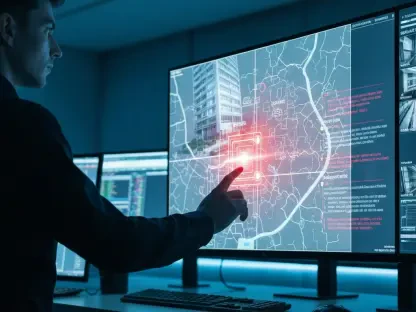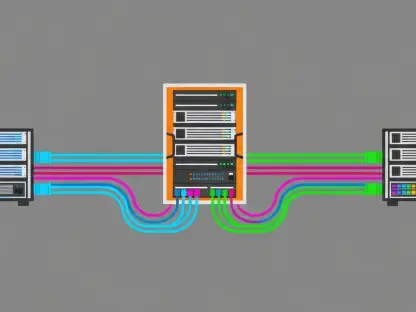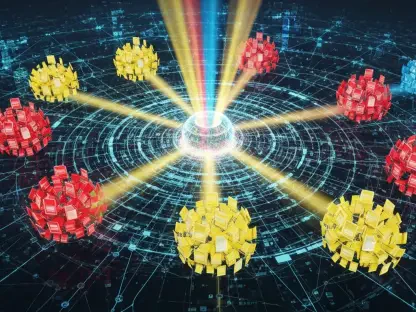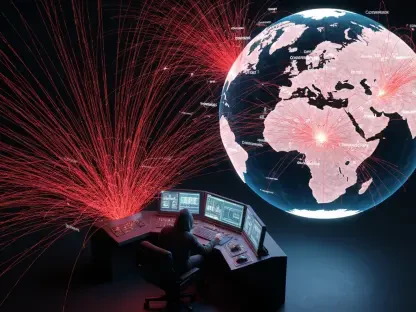In an era where global threats evolve at an unprecedented pace, the homeland security (HLS) and defense technology (DefenseTech) sectors are undergoing a profound transformation, with Milipol Paris 2025 serving as a pivotal showcase for this shift, drawing attention to cutting-edge innovations. Held from November 18th to 21st at the Paris Nord Villepinte Exhibition Center, this landmark event attracted over 1,100 exhibitors and more than 30,000 visitors from 160 countries, establishing itself as a critical hub for security innovation. Far more than a trade show, Milipol offers a window into how nations are reimagining the protection of citizens and infrastructure through groundbreaking advancements. Technologies such as artificial intelligence (AI), drones, cybersecurity, and open-source intelligence (OSINT) dominated the exhibits, signaling a move toward integrated, multi-dimensional security frameworks. These innovations are not merely tools but strategic necessities in addressing the complex, interconnected challenges of today’s threat landscape. From urban environments to cyberspace, the solutions presented at the event reflect a fundamental shift in operational paradigms, emphasizing data-driven responses over traditional methods. This article explores the defining trends and technologies unveiled at Milipol, shedding light on how they are poised to redefine the future of global security.
AI: Revolutionizing Security Operations
Artificial Intelligence has transcended its role as a supplementary tool to become the cornerstone of modern homeland security systems, a reality vividly demonstrated at Milipol. Exhibitors highlighted AI’s transformative potential through applications like facial recognition, real-time video analytics, and border monitoring, seamlessly integrating data from diverse sources such as cameras, sensors, and IoT devices. This technology empowers security forces with capabilities for anomaly detection and automated threat responses, fundamentally altering operational dynamics. Instead of direct intervention, human operators increasingly oversee algorithms, allowing for faster and more precise decision-making in high-stakes scenarios. The implications are vast, ranging from improved emergency management to enhanced surveillance in crowded urban spaces, where split-second reactions can save lives. However, the integration of AI is not without its hurdles, as the technology’s rapid adoption raises critical questions about its long-term impact on security protocols and societal norms.
Alongside its operational benefits, AI’s rise in homeland security brings forth significant ethical and regulatory challenges that were widely discussed at the event. Concerns over trust, transparency, and privacy took center stage, with many emphasizing the need for compliance with international standards like the EU AI Act. The concept of digital sovereignty also emerged as a priority, as nations seek to maintain control over AI algorithms to safeguard national interests. This push reflects broader geopolitical tensions, where dependence on foreign technology could pose risks to security. Balancing innovation with accountability remains a key focus, as stakeholders grapple with ensuring that AI systems are not only effective but also aligned with societal values. The discussions underscored that without clear guidelines and oversight, the very technology designed to protect could become a source of contention, highlighting the intricate balance required in this new era of security.
Drones and Countermeasures: Navigating Low-Altitude Challenges
The prominence of drones at Milipol underscored their dual nature as both indispensable assets and emerging threats in the realm of homeland security. These unmanned systems are revolutionizing operations, supporting tasks such as surveillance, first-responder missions, and disaster relief with unmatched flexibility and reach. Their ability to access hard-to-reach areas and provide real-time data has made them vital for modern security forces, particularly in scenarios requiring rapid response or prolonged monitoring. However, the same attributes that make drones valuable also render them potential dangers when misused. Exhibitors and experts highlighted how easily accessible drones can be repurposed as low-cost weapons or deployed in swarms to disrupt civilian spaces, a growing concern in conflict zones and urban environments alike. This duality has spurred intense focus on how to integrate drones into security frameworks while mitigating their risks.
Addressing the threats posed by drones, the event showcased advanced counter-unmanned aerial systems (C-UAS) as a critical area of development. Multi-layered approaches combining radar, acoustic sensors, and electronic warfare capabilities were presented as essential for detecting and neutralizing unauthorized aerial incursions. The urgency to secure low-altitude airspace as a new security frontier was a recurring theme, with discussions centering on the need for standardized drone fleets and dedicated training programs. Proposals for municipal aerial command centers also gained traction, reflecting a recognition that traditional air defense strategies are insufficient for urban contexts. The strategic implications are significant, as nations must adapt policies and infrastructure to manage this evolving domain, ensuring that civilian safety is not compromised by the very technologies meant to enhance it. The dialogue at Milipol made it clear that proactive, systemic solutions are imperative to stay ahead of aerial threats.
OSINT: Transforming Data into Actionable Intelligence
Open-Source Intelligence (OSINT) has undergone a remarkable evolution, emerging as a pivotal operational tool in homeland security, as evidenced by the innovations displayed at Milipol. Fueled by AI, OSINT now processes vast amounts of publicly available data from social media, videos, and other digital platforms in real time, offering security agencies unprecedented insights. Capabilities such as geospatial analysis and media transcription enable the early identification of potential threats, often before they manifest in the physical world. This shift is particularly crucial in a digital age where crises frequently unfold online first, providing a window for preemptive action. The ability to distill actionable intelligence from information overload marks a significant leap forward, equipping forces with the means to anticipate and mitigate risks in dynamic environments ranging from urban centers to international borders.
Despite its promise, the growing reliance on OSINT raises complex ethical and practical considerations that were thoroughly explored during the event. The power to monitor and analyze public data on a massive scale inevitably intersects with concerns over privacy and civil liberties, sparking debates about the boundaries of surveillance. How much data collection is justifiable in the name of security, and at what point does it encroach on individual rights? These questions lingered in discussions, with many advocating for transparent policies to govern OSINT’s use. Additionally, the accuracy and reliability of open-source data pose challenges, as misinformation can skew analyses and lead to flawed decisions. The consensus pointed toward the need for robust frameworks to balance the benefits of OSINT with accountability, ensuring that this powerful tool serves as a force for protection rather than overreach in the digital landscape.
Cybersecurity: Defending the Digital Frontier
Cybersecurity has solidified its position as a fundamental pillar of national security, a reality emphasized through the exhibits and discussions at Milipol. No longer confined to IT departments, cyber defenses now extend to safeguarding smart cities, critical infrastructure like energy grids and transportation networks, and government systems against increasingly sophisticated attacks. Multi-layered defense architectures and AI-driven threat detection systems were prominent, showcasing how technology can identify and neutralize digital risks in real time. The stakes are high, as digital vulnerabilities can translate into tangible disruptions, from power outages to halted public services. The focus on cybersecurity reflects a broader understanding that in an interconnected world, a breach in the virtual realm can have cascading effects on physical safety, making robust defenses as essential as any physical barrier.
Beyond technical solutions, the event highlighted the importance of digital sovereignty and international collaboration in addressing cyber threats. Many nations are prioritizing control over their data and supply chains to reduce reliance on foreign technology, a move driven by concerns over potential exploitation or espionage. At the same time, shared cyber-intelligence platforms and joint alert systems were showcased as vital for countering global cyberattacks that transcend borders. This dual approach—strengthening national autonomy while fostering cooperation—underscores the complexity of the cyber landscape. The consensus was that no single entity can tackle these challenges alone; unified methodologies and trust-building measures are necessary to protect critical systems. As digital threats continue to escalate, the dialogue at Milipol reinforced that cybersecurity must remain a top priority, intertwined with every aspect of homeland security strategy.
DefenseTech and HLS Convergence: Bridging Military and Civilian Security
A striking trend at Milipol was the accelerating convergence of DefenseTech and homeland security, blurring the traditional boundaries between military and civilian applications. Technologies once exclusive to battlefields, such as advanced robotics and high-end surveillance systems, are increasingly being adapted for HLS missions like border protection and urban monitoring. This overlap reflects a growing recognition that many threats—whether terrorism, organized crime, or cyberattacks—require solutions that draw from both domains. The result is a demand for versatile, secure systems that can transition seamlessly from development to deployment in diverse contexts. This shift not only enhances operational capabilities but also signals a broader redefinition of security, where the tools of warfare find relevance in protecting everyday life against multifaceted dangers.
This convergence also creates a fertile ground for innovation, particularly for startups and smaller tech companies looking to address niche security challenges. The event spotlighted how shorter sales cycles and the need for rapid deployment favor agile players who can offer tailored solutions over bureaucratic giants. However, the path forward is not without obstacles, as the insistence on digital sovereignty and adherence to strict regulatory standards adds layers of complexity. Providers must navigate a landscape where technical excellence alone is insufficient; alignment with national priorities and international norms is equally critical. The opportunities are vast for those who can strike this balance, as the merging of military and civilian security needs continues to drive market growth. Milipol served as a reminder that adaptability and compliance will be key to capitalizing on this evolving intersection of technology and security.
Emerging Horizons in Global Security
Reflecting on the insights from Milipol, it became evident that the homeland security and defense technology sectors had reached a critical juncture by late 2025. The event illuminated a landscape driven by AI, drones, OSINT, and cybersecurity, where integrated systems had begun to redefine how threats were anticipated and countered. Each innovation, from automated threat detection to multi-layered cyber defenses, had demonstrated its potential to enhance safety on a global scale, while also exposing the ethical and regulatory challenges that accompanied such rapid progress. The convergence of military and civilian technologies had opened new pathways for collaboration and market expansion, reshaping the very definition of protection in an interconnected age. Looking ahead, the focus must shift to actionable steps: nations and organizations should prioritize the development of sovereign, data-driven solutions while fostering international partnerships to address shared risks. Investing in training and policy frameworks that keep pace with technological advancements will be essential, as will ensuring that innovation does not outstrip accountability. As the security landscape continues to evolve, the lessons from Milipol offer a blueprint for navigating the delicate balance between progress and responsibility, urging stakeholders to build systems that are as ethical as they are effective.









